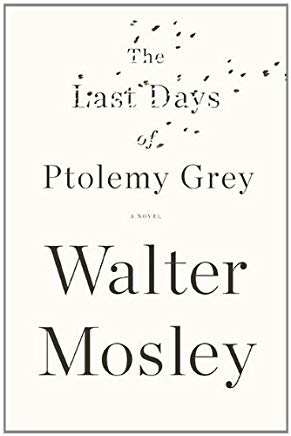Walter Mosley
Riverhead Books
New York
2010
277 pages
According to the Art:
Through his main character, Mosley imagines what it could be like to experience dementia, and also to have a sense that you are experiencing it. He also challenges us to think about how dementia should be treated and about access to experimental drugs without regulatory oversight.
Synopsis:
Walter Mosley writes in various genres but is probably best known for his mysteries. His 2010 novel, The Last Days of Ptolemy Grey, could be considered another one of his mysteries, but the mystery plot takes a secondary role. Featured more prominently is the struggle the main character, Ptolemy Grey, has with dementia.
The reader first encounters Ptolemy Grey when he is ninety-one-years old and living alone in an apartment he has inhabited in South Central LA for more than sixty years. Both he and the apartment are in appalling shape. The apartment is cluttered, disorganized, and dysfunctional, as is his aging brain. He knows his mind is failing and seems to him as if it “had fallen in on itself like an old barn left unmended and untended through too many seasons.” (p.153)
Throughout the novel, Mosley presents aspects of dementia and some of its oddities. For example, while Ptolemy is riding on a bus through his town, certain sights trigger clear memories from his childhood eighty years before. At the same time he is unsure where he is going or why. Mosley also shows how people can possibly realize they are slipping into dementia, for example, when Ptolemy stops talking to a friend once “he could see in her eyes he wasn’t making sense.” (p. 122)
Ptolemy’s great-grandnephew Reggie provides him with the assistance he needs to barely maintain his lonely existence in squalid conditions. When Reggie dies, a new person comes into his life. Robyn, a seventeen-year-old orphan living with Ptolemy’s grandniece, begins to straighten out his apartment and then his mind.
As Robyn gets Ptolemy’s apartment more organized and functional, Ptolemy’s mind starts to get more organized and functional as well, but only a bit more. Unsatisfied with his progress, Robyn takes Ptolemy to a physician who has an experimental drug for dementia. Ptolemy is told that if he takes the drug he will regain his mental acuity but probably not live more than a few weeks, or months, at best. Without hesitation he takes the drug—“I wanna make it so I could think good for just a couple a mont’s, Doc” (p. 126)—and rapidly regains many memories and mental capacities. During the time he has with his newfound mental agility, Ptolemy is able to make good on a commitment from his childhood and to solve the mystery of Reggie’s death. While the experimental drug enables Ptolemy to wrap up his business, it also produces a rather violent end to his life.
Analysis:
Readers looking for a sophisticated and riveting mystery will not be satisfied with this novel. Mosley has seemingly used the mystery in this book as a medium to convey some thoughts he has on dementia. Thus, the book will probably be more satisfying to readers interested in what people with dementia may be experiencing and in some of the dicey questions around treating people with dementia. Mosley knows wherefrom he speaks about dementia, having observed and cared for his mother as she tried to cope with it. This experience, along with his literary skills, results in some compelling images of what it could be like to have dementia and produces some interesting questions about research and treatments.
That people with dementia eventually lose the ability to communicate makes it difficult for us to know for sure what they experience. We have to imagine it as best we can from observing the specific struggles dementia causes. Mosley watched his mother and did his best to translate his observations of her into Ptolemy’s experience:
That’s how Ptolemy imagined the disposition of his memories, his thoughts: they were still his, still in the range of his thinking, but they were, many and most of them, locked on the other side of a closed door that he’d lost the key for. So his memory became like secrets held away from his own mind. But these secrets were noisy things; they babbled and muttered behind the door, and so if he listened closely he might catch a snatch of something he once knew well.
p. 12
Mosley confronts current dementia treatment approaches when he sets up a choice for Ptolemy to either maintain a slow but inexorable progression into deeper dementia or to try a drug that may restore mental function but kill him soon after he starts taking it. Few people question whether a cure for dementia should be sought, but current treatments just slow progression of the condition—and not very effectively at that. Mosley may be daring us to think about whether merely slowing the progression of dementia and prolonging the associated misery is what people with dementia and their caregivers really want. This is a difficult debate to have in the public sphere, and perhaps Mosley has helped to initiate it through this story.
In publishing this novel in 2010, Mosley anticipated the “right to try” legislation that would start sweeping across the U.S. beginning in 2014. Ptolemy gets access to an experimental drug illegally because the U.S. Food and Drug Administration (FDA) had not sanctioned its use for approved or experimental purposes. Access to experimental treatments without requiring FDA approval is at the heart of right to try laws. Through Ptolemy’s plight, Mosley elaborates on individual contexts that can drive the interest in unfettered access to experimental drugs, but also shows how experimental drugs can cause suffering as well.
Also:
This novel was made into a TV series on Apple TV+
A version of this review is posted here at the NYU Literature, Arts and Medicine Database.



